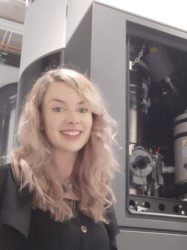Summary
Dr Shelly Conroy is a Royal Society University Research Fellow, specialising in in-situ transmission electron microscopy (TEM) and electron energy loss spectroscopy (EELS). The Conroy group at Imperial design quantum and energy materials at the atomic scale using electron and atom probe microscopy techniques. Her group is part of the new cryo-microscopy facility for engineering and physical sciences at Imperial and the Royce Imperial ‘Atoms to Devices’ thin film growth facility.
Dr Conroy worked at Pacific Northwest National Laboratory as a permanent staff scientist before joining the University of Limerick as a Science Foundation Ireland Analog Devices Research Fellow (PI). Dr Conroy holds a PhD in AlN thin film growth for optoelectronic device applications and in-situ TEM from Tyndall National Institute and University College Cork Ireland.
Dr Conroy’s URF grant ‘Improper Ferroelectric Domain Wall Engineering for Dynamic Electronics’ is focused on thin film growth of the ferroelectric/ferroelastic boracites and in-situ 4DSTEM strain analysis. The project is in collaboration with the National Center for Electron Microscopy at Lawrence Berkeley National Laboratory and SuperSTEM the EPSRC National Research Facility for Advanced Electron Microscopy. LCN seminar series
In 2019 Dr. Conroy was awarded an SFI Industry Research PI grant with Analog Devices; ‘Dynamic Atomic Interface Characterisation for Improved Performance of Electrical and Magnetic Devices’. Shelly investigated magnetoresistance devices based on dynamic magnetic domain walls via MOKE and differential phase contrast STEM while applying bias and heat. She investigated in-situ the electrical breakdown and material phase change at the atomic scale of high voltage isolation polymer products and conducting PEDOT polymers. In-situ TEM Video
At the Department of Physics in University of Limerick Dr. Conroy was also working on the NSF/SFI funded US Ireland ‘Conducting Domain Walls for Novel Nano-Electronics’ project within Prof. Ursel Bangert’s (PI on grant) group. Here she investigated ferroelectric domain wall structure at the atomic scale by aberration corrected STEM and probing their band structure via electron spectroscopy. She used in-situ heating and biasing TEM to investigate the dynamic changes at these boundaries. This project was in collaboration with Prof Marty Gregg’s group at Queens University at Belfast and Prof Alexei Gruverman’s group at University of Nebraska-Lincoln.
Dr Conroy was a postdoctoral researcher at Pacific Northwest National Laboratory within the DOE Nuclear Processing Science Initiative. She focused her research on high resolution and in-situ electron microscopy techniques including STEM EDS, EELS, thermal annealing, liquid cell and cryo. Rad FIB video She was promoted to permanent staff scientist in 2017 within the Energy and Environment Directorate.
Associate Editor:
Professional Societies:
IEEE UFFC Publicity Committee Chair
Institute of Physics EMAG Committee Member
Selected Publications
Journal Articles
Moore K, O'Connell EN, Griffin SM, et al., 2022, Charged domain wall and polar vortex topologies in a room-temperature magnetoelectric multiferroic thin film, ACS Applied Materials & Interfaces, Vol:14, ISSN:1944-8244, Pages:5525-5536
Hadjimichael M, Li Y, Zatterin E, et al., 2021, Metal-ferroelectric supercrystals with periodically curved metallic layers, Nature Materials, Vol:20, ISSN:1476-1122, Pages:495-+
Moore K, Bangert U, Conroy M, 2021, Aberration corrected STEM techniques to investigate polarization in ferroelectric domain walls and vortices, Apl Materials, Vol:9, ISSN:2166-532X
Moore K, Conroy M, O'Connell EN, et al., 2020, Highly charged 180 degree head-to-head domain walls in lead titanate, Communications Physics, Vol:3, ISSN:2399-3650

